I have a utility program from FSDeveloper that can display the data encoded in the Nav BGLs, and I have compared the LAT/LON and elevation of the KLAX ILS 24R ILS glideslope with the official data from the FAA at enasr.faa.gov and the MSFS GS is exactly correct in both default NavBlue data and Navigraph replacement core navdata.
Here is the official FAA record:
Navaids in MSFS are automatically placed (at least for default airports) by the core navdata BGLs. I have looked at many airports in the US in MSFS and I have never found a localizer or glideslope that is incorrectly placed either in terms of LAT/LON or elevation per official FAA records.
I can not say the same for other parts of the world, as I do not have access to an official source of navaid data that is the equivalent of the FAA’s ENASR.
Glideslope or localizer antennas that may appear in the airport scenery are just objects that are placed in the scenery by the developer. They may or may not be placed correctly, but the simulated ILS localizer and glideslope do not come from the location in the scenery where those objects are placed.
The same holds true for PAPIs. There is not an official database of exact PAPI LAT/LON as there is for ILS localizers and glideslopes. They have to be placed by the scenery developer, and if they are not in the correct real-world location, the visual glidepath may not correspond with the ILS glideslope.
It should be noted though that at quite a few r/w airports, the PAPI glidepath and ILS glideslope do not match. There will usually be a note about this on the r/w approach chart when this situation exists.
Now, scenery developers who build custom airports can create custom navdata that will override the default data, in which case it is up to them to get it correct.
There are several factors that can cause glideslope errors in MSFS even though the actual glideslope is placed exactly right per FAA data.
When a runway is created in the SDK scenery development interface, the developer has to specify the exact LAT/LON of the runway threshold, its length, width and magnetic heading. If any of those are wrong, then ILS components may not line up correctly. Runway touchdown zone markings are another potential source of errors. In the “standard” airport scenery development interface, runway markings are automatically created based on the type of markings (precision or non-precision) and are placed a standard distance from the runway threshold.
Developers can create custom runway markings, but that takes considerably more work.
Another potential source of errors is if the elevation of the MSFS terrain is incorrect. The ILS glideslope transmitter is paced at a specific MSL elevation per the FAA data, but if the elevation of the runway surface is wrong in the base MSFS terrain, that can make the glideslope radiate either from below ground or too far above ground, so the point where it intersects the runway touchdown zone will be wrong.




![KLAX ILS24R Autoland Fenix A320 [RTX4090]](https://img.youtube.com/vi/W-hd5Kzyfzk/maxresdefault.jpg)
